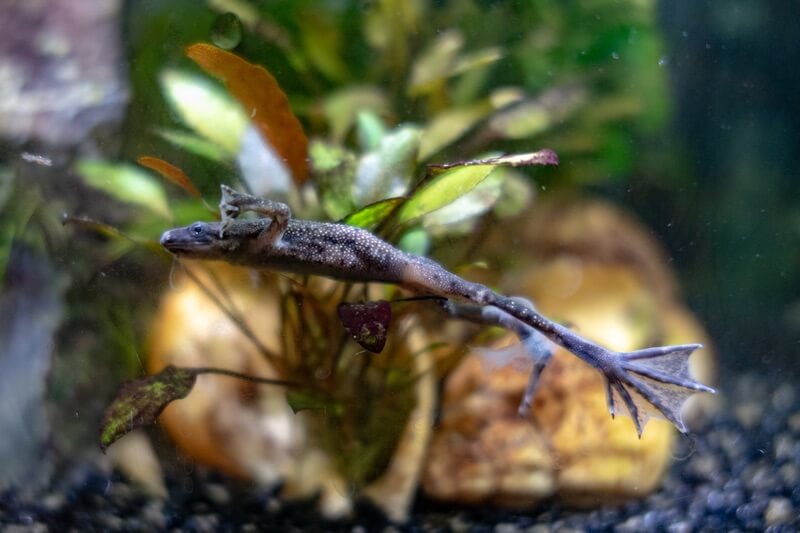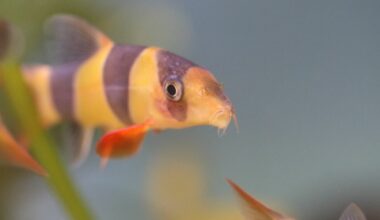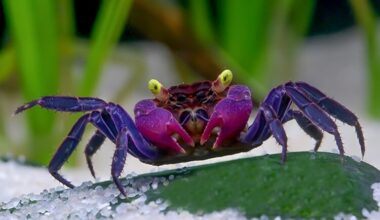
If you’re looking for a freshwater addition to your tank that’s a little bit different, you should definitely consider the African Dwarf Frog.
These are one of the most popular aquatic frogs for a few reasons.
They’re busy and active creatures that can be very enjoyable to observe. It doesn’t matter when you happen to be near your tank, they always seem to be up to something!
Also, African Dwarf Frogs only require a moderate level of care and get along great with their tank mates.
What’s not to like?
Quick Facts 
| Scientific Name: | Hymenochirus |
| Other Names: | Dwarf Clawed Frog |
| Lifespan: | 5 years |
| Size: | 3 inches |
| Care: | Difficult |
| Diet: | Omnivores |
| Water Conditions: | 72°F-78°F, 6.5-7.8pH, 5-20dKH |
| Tank Size: | Between 3 and 5 gallons |
| Behavior: | Active |
| Breeding Difficulty: | Easy |
Table of Contents
Species Summary
African Dwarf Frogs are distinct little creatures that make an interesting addition to home aquariums.
Originally found in Nigeria, Cameroon, and the Congo river basin, these amphibians spend most of their time underwater. In the wild, they can be found in shallow rivers and ponds.
While they were first classified in the late 1800s, it wasn’t until the 1970s that they became popular among aquarists.
Author Note: Due to their unique lifestyle and habitat requirements, African Dwarf Frogs can now be found in pet stores and aquariums around the world.
The Average Lifespan Of An African Dwarf Frog
The average African Dwarf Frog lifespan is typically no longer than 5 years. This can vary significantly based on the level of care that they receive and the health condition they were in when you purchased them.
Appearance and Size
When it comes to the average African Dwarf Frog size, most don’t get any longer than 3 inches.
In the wild, African Dwarf Frogs spend much of their time blending in with the bottom of river beds and ponds. They’re able to do this thanks to their muted appearance.
Green or Brown? These frogs take on a base color that lies somewhere between deep olive green and muddy brown.
The belly and legs tend to be on the lighter side. Regardless of what their base color is, the frogs are covered in black spots. They help to camouflage the frog among leaves, mud, and plants. However, there are some differences when it comes to sex.
Females can be as much as 40 percent larger than males (who protects who?). Plus, they have a more pear-shaped body and a pronounced genital region. Males African Dwarf Frogs also have glands behind their front legs.
Author Note: While subtle, the white glands do create a slight bulge that’s easy to identify. Not much is known about what these glands do, but it’s theorized that they play an important role in breeding.
Aside from their shape, African Dwarf Frogs do have some distinct physical characteristics. They’re a part of the Pipidae family (within the Hymenochirus genus). This means that they have don’t have a tongue or any teeth.
Author Note: To eat, the frogs will use their webbed feet to shove food into their mouths and down their throats. They also lack ears. To navigate their environment, they use a lateral line to detect vibrations in the water.
Avoiding a Common Mistake
It’s very easy to mistake African Dwarf Frogs for African Clawed Frogs. In fact, it’s not uncommon to see them wrongly labeled at the pet store! While they look very similar, there are a few telltale signs to distinguish between the two species.
Main Differences
- African Dwarf Frogs have webbed feet. All four of the feet are used for swimming.
- African Clawed Frogs as the name would suggests, have individual fingers and long claws on their front legs.
How about the eyes?
- You can also tell the difference from the frog’s head. African Dwarf Frogs have eyes on the side of their head and a more pointed snout.
- When compared to the African Clawed Frog’s broad snout and higher eye position, the two species look totally different.
African Dwarf Frog Care
Don’t let the cute looks of an African Dwarf Frog fool you. They should not be handled with bare hands. It’s pretty common to see these frogs being used as pets to curious children.
Unfortunately, this often leads to a host of health problems. Not just for the frog, but also the person touching them. You see, amphibians like the African Dwarf Frog carry all kinds of diseases on them.
These frogs are not venomous, but the diseases they carry could be passed on to humans. One of the worst offenders in salmonella. If you ever have to touch them, use a net or wear gloves to stay safe.
Water not Air! Another problem that comes with playing with an African Dwarf Frog is their sensitivity. These creatures spend all of their time under the water, only rising up to the surface to get a breath of fresh air.
Taking them out of the water for only 15 minutes can lead to extreme dehydration and potentially death!
This is because their skin is simply not made to be in dry environments. They thrive in moisture and areas with high humidity, so it’s best to leave them in their tanks.
Author Note: African Dwarf Frogs will shed their skin quite often. This is a normal process that you should not worry about as long as their dead skin is actually shedding, and not staying on their body.

Potential Health Problems To Be Aware Of
African Dwarf Frogs are also susceptible to a host of health problems. Bacterial infections have been known to cause redness in their eyes and skin.
- Symptoms. They can also cause behavioral changes like lethargy and a loss of appetite. Luckily, antibiotics are very effective in treating bacterial infections.
- Other Infections. The frogs can also experience fungal infections. In most cases, fungal infections manifest themselves through fuzzy patches of skin on the frog’s body.
While they look innocent enough, fungal infections should be taken very seriously. One of the worst types of infections, Chytridiomycosis, can easily spread to other frogs.
Author Note: If you see a fungal infection starting to affect one frog, you need to separate it from the others to avoid a full-blown infection in your tank.
The same goes for a disease called dropsy. The issue with dropsy is that it’s very difficult to find out what caused it. It could be caused by anything from bacteria to invasive parasites.
Whatever the case may be, it’s important to seek veterinary care if possible. The first sign of the disease is bloating and anxious behavior. If it’s left untreated, dropsy can prove to be fatal for your little frog.
What Water And Tank Conditions Do They Need?
Based on the previous section, you might think that African Dwarf Frogs are magnets for health issues. Truth is, a lot of those issues can be avoided by providing your frog with a healthy diet and keeping them in ideal living conditions.
A healthy habitat with recommended water conditions is key when it comes to caring for these frogs.
Here are the recommended values you should know:
- Water temperature – African Dwarf Frogs do best in temperatures between 72 and 78 degrees Fahrenheit.
- pH level – This should be between 6.5 and 7.8.
- Water hardness – This is a generous gH level range of 5-20.
Recommended Tank Size
Ideally, the size of your tank should between 3 and 5 gallons for each African Dwarf frog.
They don’t require much space at all, but they do enjoy having some room to roam. If you only have a couple of frogs, a 10 to 15 gallon tank should suffice.
Remember, wild frogs live in shallow rivers and ponds. They also like to move into flooded forests during the rainy season. Deep tanks are not recommended.
Tank Setup
The frogs have to be able to swim up for air regularly. They also happen to be bottom-dwellers that tend to stick to the substrate. To ensure that they can get air when they need it, keep tank depths reasonable.
The bottom of the tank should have a fine substrate like sand. Gravel works too, but the individual pieces need to be large enough to prevent your frogs from swallowing them.
As for decorations, live plants are always best. Frogs can feed off the plants and use them to hide.
Author Note: If you get large plants with leaves that reach the surface, don’t be surprised if you find your frog lounging on top of it.
Plants falling down?
Make sure that all of your plants are properly secured underneath the substrate. African Dwarf Frogs are notorious diggers that will dislodge your plants if given the opportunity. To complement the plants, add plenty of hiding spaces with rocks and wood.
Filter And Lighting Considerations
One thing you’ll want to keep an eye on initially is your filter. Anything too strong could cause problems for your frogs.
Despite having the ability to swim down to the bottom of the tank, African Dwarf Frogs aren’t too keen on strong currents. So, you’ll need to make sure that the filter and any air columns you have are reasonable.
Lastly, you’ll want to provide adequate lighting for 10 to 12 hours a day. African Dwarf Frogs are nocturnal, but they use that light to stay on a healthy time cycle.
Fortunately, you won’t need to rush out and pick up a fancy light setup. Standard aquarium lights will do just fine.
African Dwarf Frog Food & Diet
Technically speaking, African Dwarf Frogs are omnivores that can eat plant-based materials. However, they do best with meaty foods. In the wild, the frog’s diet consists primarily of small fish and insect larvae.
To give your frog the best diet possible, offer a variety of different high-protein foods. This could include brine shrimp, fish fry, bloodworms, and even small earthworms. You can also give them a flavorful treat once a week!
Frogs love fatty foods like beef heart, salmon, or tuna. Just make sure to reserve these foods to once a week treats. These frogs can gain weight pretty easily, so you don’t want to overfeed them.
African Dwarf Frogs don’t need to eat every single day. With high-quality food, they do just fine eating three or four times a week. When you feed them, make sure to not give them too much food.
You should only give them as much food as they can eat in one sitting. African Dwarf Frogs are passive eaters. So, if you leave behind food, it will only sit there and negatively impact the water quality.
When you do feed them, consider doing so with a pair of long tweezers. Make some noise to attract their attention and guide the food to them.
Most frogs aren’t going to swim up to the surface to eat, as they spend most of their time at the bottom of their environment.
General Behavior & Temperament
It’s no doubt that one of the reasons African Dwarf Frogs are so popular is because they’re fun to watch. They’re quite active once the sun goes down. As we mentioned, the frogs spend most of their time underwater.
While they are aquatic by nature, they actually have a full set of developed lungs.
This means they’ll swim rapidly to the top of the water to get a breath. Then, they’ll swim down to the bottom and explore.
If they feel threatened, these frogs will use their natural camouflage to hide from predators. They’ll swim beneath rocks or stay within foliage to stay out of sight. Without any threats in their tank, you might see some quirky behavior.
African Dwarf Frogs love to float at the water’s surface with their arms spread out. At first glance, it’s easy to think that they’re dead. But don’t worry, they’re just relaxing!
The frogs are very docile by nature and work well with others. The only temperament issues you might encounter are with small fish. They might view the fish as food and try to eat them.
Other than that, African Dwarf Frogs are fun creatures to watch. They can also be very vocal. Males make buzzing sounds to attract females.
What Are Good Tank Mates For African Dwarf Frogs?
The best companions for these frogs are other African Dwarf Frogs. They’re very social and do best in groups of 3 or 4. However, you don’t have to always stick them with their own kind.
They’re great communal creatures that can live harmoniously with peaceful fish. Some good examples of these are:
- Guppies
- Corydoras
- Tetras
Any other non-aggressive fish are ideal and can be considered as well. However, make sure that the fish you pair your frog with aren’t small enough to eat.
You can even introduce other bottom dwellers into the tank. Large snails and some shrimp species will leave the frogs alone, which is a good thing.
As long as the companion creatures aren’t small enough to eat, you shouldn’t encounter any problems.
Do They Get Along With Bettas?
African Dwarf Frogs and bettas can live together in some situations, but not in others. This has nothing to do with the frogs since they’re super friendly.
It’s all about the bettas that you have in your tank.
If they are on the more tolerant side then you can probably pull off this pairing. However, if they’re aggressive you could have a problem on your hands.
Think about the temperament of your fish before you consider this. If you’re on the fence, play it safe and keep them separate (and consider one of these betta tanks).
How To Breed African Dwarf Frogs
Breeding African Dwarf Frogs is a unique process. It’s not that difficult, but it does require some careful preparation. If done right, you could end up with hundreds of little tadpoles to take care of!
The first step is to initiate the breeding process. To do this, you’ll have to simulate the breeding season in the wild. Over the course of a month, lower the water levels in the tank to about 7 centimeters, or less than 3 inches.
This simulates the dry season in their native Africa. After you have reached that desired shallowness, fill the tank back up with warm water that’s about 85 degrees Fahrenheit. Maintain this temperature for a couple of weeks.
Author Note: As you’re performing this water change, give your frogs plenty of food to eat. Consider mixing the food up each time to provide the frogs with variety.
You’ll know that you have initiated breeding when the female starts to get larger. This means that she’s filling up with eggs that are ready to be fertilized. Then, it’s just a matter of time before the mating ritual begins.
When African Dwarf Frogs breed, the male will cling onto the lower half of the female’s body. The female will then swim to the surface of the water with the male in tow. As she swims, she’ll release eggs into the water.
The male will fertilize those eggs by releasing sperm into the water behind her. Once this ritual has commenced, you should move the adult frogs into a holding tank to give the eggs time to hatch. Hatching only takes between 3 and 6 days.
Once the tiny tadpoles have hatched, feed them infusoria before moving onto brine shrimp. Give the tadpoles time to grow their legs and turn into frogs before reintroducing them to the adults.
The Wrap Up
African Dwarf Frog care can be a fun and rewarding process that doesn’t bring on much hassle. In our opinion, it doesn’t get any better than that!
If you have any questions don’t hesitate to reach out to us and don’t forget to tag us on Facebook when sharing cool photos. Now that you know the essential info you need to take care of these animals, all that’s left is for you to go out and get some! African Dwarf Frogs are very common, so you shouldn’t have any trouble finding them at your local aquarium shop.
It will be well worth it.

